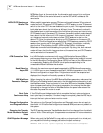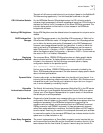
48 NETBUILDER SOFTWARE VERSION 11.1 RELEASE NOTES
■ SDLC end-to-end through local switching (conversion to a single LLC2 LAN
connection between two NETBuilder bridge/routers) requires different virtual
ring numbers in the LLC2 Service.
SDLC Adjacent Link
Stations for APPN
When you configure SDLC adjacent link stations for APPN, if an active link
becomes inactive and you change the port definition using the PortDef parameter,
the link remains inactive. If you try to reactivate the link using the SET -APPN
LinkStaCONTrol command, the link reactivates within 30 seconds. To activate the
link immediately, you must enable the APPN port using the SET -APPN PortControl
= Enable command.
Source Route
Transparent Bridging
Gateway (SRTG)
Interoperability
The NETBuilder II bridge/router cannot interoperate with Cisco or IBM routers if
the NETBuilder bridge/router is configured using Source Route Transparent
Gateway (SRTG) with Source Route bridging on the token ring LAN port and
Transparent Bridging on the PPP or Frame Relay WAN ports. In this configuration,
the NETBuilder II bridge/router is sending using PPP bridge encapsulation 802.5
token ring format, while the IBM 6611 and the Cisco 400 router are using PPP
bridge encapsulation 802.3 Ethernet format.
SDLC Ports and NetView
Service Point
An SDLC port defined for NetView Service Point cannot be used for SDLC-to-LLC2.
Source-Route
Transparent Gateway
The source-route transparent gateway is not currently supported on ATM LAN
emulation ports.
Token Ring+ Modules The maximum physical frame size that can be forwarded by the Token Ring+
modules with NETBuilder bridge/router software is 4,500 bytes. This software
limitation affects routing, source route bridging, and transparent bridging.
Token Ring Auto Start-up
The Token Ring and Token Ring+ modules may enter the ring at the wrong speed
with certain MAU or station configurations. You can manually configure the -PATH
BAud value to 16,000 or 4,000 to avoid this situation.
VRRP Configuration VRRP cannot coexist with DECnet, LAA, OSI, or IPv6.


















